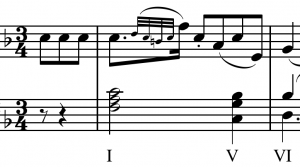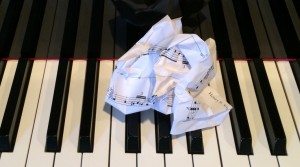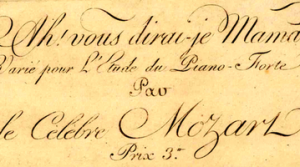You may know that I am a fan of Coursera, an aggregate site of short and usually free online courses presented by University professors from around
Below is the first part of my Write Like Mozart Week 5 Notes that I sent my students last year when we took the Write Like Mozart class together. The Write Like Mozart class is online again at the time of these posts. Each of these posts are timed to match the current week of that class.
In this installment, I discuss the chromatic substitutions for harmonies that were presented in the lectures: the Neapolitan, Augmented 6th, minor iv, ♭VI, and major I (Picardy third) chords.
This is the seventh post in this series.
Below are the Write Like Mozart Week 4 Notes that I sent my students last year when we took the Write Like Mozart class together. The Write Like Mozart class is online again at the time of these posts. Each of these posts are timed to match the current week of that class.
In this installment, I review diatonic substitutions, types of cadences, parallel / question and answer form, creating a solo with piano accompaniment from simple 2 part counterpoint, and the “Rule of 2.”
This is the sixth post in this series.
I am in week three of my Masters’ of Fine Arts degree in composition with the University of Birmingham’s distance learning program. I just finished my third Skype lesson with composer Dr. Michael Zev Gordon.
In the course of the past 2.5 weeks, I have studied half a dozen or more works by Chopin, Mahler, Debussy, Stravinsky, and Berio – a somewhat varied collection of composers that only promises to grow more eclectic and modern as we move through the program. I also have written three short pieces totaling somewhere between 7 and 8 minutes in length. Even though these works will be revised, and they each are for solo instruments, the productivity is very good when I consider that I am working in new territory, and I usually write at most 30 minutes of music in a year.
So, I was surprised when, in the middle of last week, I experienced some quiet echoes of the self-doubt that had paralyzed me as a composer more than 15 years ago.
This is a continuation of my series of notes from when my students and I took the online Write Like Mozart class last year.
Between the 3rd and 4th week of the course, I had an epiphany on the merits of what Professor Edwards calls Texture Reduction and the application of patterns. Here I speak of how Professor Edwards’ approach to teaching music theory as a generative process differs from what I experienced in school and the wonders of applying patterns to textural reductions. A few quick hints are offered at the end of the post.
This is the fourth post in this series.




